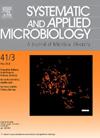N-glyceroyl alkylamine phosphoglycolipids dominate the lipidome of several Bacillota bacteria
IF 4.2
2区 生物学
Q2 BIOTECHNOLOGY & APPLIED MICROBIOLOGY
引用次数: 0
Abstract
Elucidation of the membrane lipid composition of bacteria can help to better understand how bacterial cells interact with their surroundings, adapt to environmental stress, and resist antimicrobial agents. Here we describe for the first time the detection of a wide array of N-glyceroyl alkylamine phosphoglycolipids (NGAPs) in a range of Bacillota bacteria (formerly Firmicutes). Bacillota includes a diverse range of bacteria that are typically highly resistant to harsh conditions such as heat, radiation, and pH, allowing the bacteria to survive in unfavorable environments. In 9 out 18 investigated strains of Bacillota, spread across 5 orders (Thermoanaerobacterales, Thermosediminibacterales, Eubacteriales, Halanaerobiales, and Sulfobacillia) mild acid hydrolysis released N-glyceroyl alkylamines (NGAs), which were detectable by gas chromatography–mass spectrometry (GC–MS) during routine fatty acid analysis. One strain, Moorella thermoacetica was found to produce long-chain NGAs (C30-C32), which are postulated to have isodiabolic acid-like structures. A wide variety of intact polar NGAPs were identified using ultra-high pressure liquid chromatography high resolution multi-stage mass spectrometry (UHPLC-HRMSn). These include many previously undescribed lipids with a variety of sugar moieties and glycerol-bound core lipid moieties, including ether-bound components and alkyl 1,2-diols. The NGAPs constituted the majority of the intact polar lipid composition of these strains and presumably contribute to their tough cell membranes. The presence of NGAs in Bacillota appears to be associated with thermophilia. Both the hydrolysis-derived NGAs and intact polar NGAPs have potential to be biomarkers for extremophilic and, in particular, thermophilic bacteria.
n -甘油酰烷基胺磷酸糖脂在几种芽孢杆菌的脂质组中占主导地位
阐明细菌的膜脂组成有助于更好地了解细菌细胞如何与周围环境相互作用,适应环境应激和抵抗抗菌剂。在这里,我们首次描述了在一系列杆菌门细菌(以前的厚壁菌门)中检测到广泛的n -甘油酰烷基胺磷酸糖脂(NGAPs)。杆状菌包括各种各样的细菌,这些细菌通常对高温、辐射和pH等恶劣条件具有很强的抵抗力,使细菌能够在不利的环境中生存。分布于5个目(热厌氧杆菌目、热沉积杆菌目、真细菌目、耐氧杆菌目和硫杆菌目)的18株芽孢杆菌中,有9株的温和酸水解释放出n -甘油酰烷基胺(NGAs),在常规脂肪酸分析中可通过气相色谱-质谱联用(GC-MS)检测到。一种菌株,热醋酸摩尔菌被发现产生长链NGAs (C30-C32),被认为具有异二代谢酸样结构。采用超高压液相色谱-高分辨率多级质谱法(uhplc - hrms)鉴定了多种完整的极性ngap。这些包括许多以前描述过的具有各种糖部分和甘油结合的核心脂质部分的脂质,包括醚结合的成分和烷基1,2-二醇。NGAPs构成了这些菌株完整的极性脂质组成的大部分,可能有助于它们坚韧的细胞膜。芽孢杆菌中NGAs的存在似乎与嗜热性有关。水解衍生的ngap和完整的极性ngap都有可能成为嗜极细菌,特别是嗜热细菌的生物标志物。
本文章由计算机程序翻译,如有差异,请以英文原文为准。
求助全文
约1分钟内获得全文
求助全文
来源期刊

Systematic and applied microbiology
生物-生物工程与应用微生物
CiteScore
7.50
自引率
5.90%
发文量
57
审稿时长
22 days
期刊介绍:
Systematic and Applied Microbiology deals with various aspects of microbial diversity and systematics of prokaryotes. It focuses on Bacteria and Archaea; eukaryotic microorganisms will only be considered in rare cases. The journal perceives a broad understanding of microbial diversity and encourages the submission of manuscripts from the following branches of microbiology:
 求助内容:
求助内容: 应助结果提醒方式:
应助结果提醒方式:


